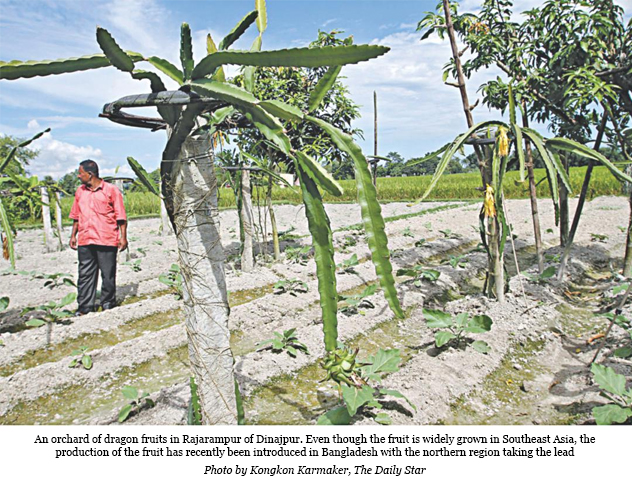Pitaya, also known as dragon fruit, is being cultivated for the first time in the northern part of Bangladesh thanks to favourable growing conditions. It usually grows in Southeast Asian as well as Central and South American countries.

Horticulture Centre of the Department of Agriculture Extension is promoting the fruit for commercial farming among farmers in Dinajpur, Thakurgaon, Panchagarh and Nilphamari.
Officials said 15 farmers planted dragon fruit saplings in 2013 and early 2014. Six more farmers followed suit in late 2014 and early 2015. Of them, 14 farmers are from Dinajpur, four from Panchagarh, two from Thakurgaon and one from Nilphamari.
Each farmer has planted 80 saplings on their land alongside other crops.
Visiting dragon fruit orchards in Dinajpur early this month, this correspondent found the trees planted in 2013 and early 2014 started flowering.
To maintain the upright growth of the plants, farmers used concrete columns for their support. Each immature plant stems are tied to these columns. And, a circular metal frame is installed over the columns for a balanced growth.
Farmers said the saplings must be planted on an open field so that they can get direct sunlight.
Each plant can continue to bear fruits for 20 years, said horticulturists in Dinajpur.
Farmer Babul Chandra Roy of Sheikhpura village under Dinajpur Sadar upazila said he planted 80 saplings in mid 2014 and one of his plants started yielding fruit this year. “I hope the fruit will be popular in Bangladesh,” he added.
Imrul Ahsan, deputy director of Horticulture Centre in Dinajpur, said dragon fruit is healthy and nutritious. It strengthens the immune system and is used in the treatment of diabetes. Medicine made from its flower and stem improves blood circulation.
The potential of dragon fruit is bright in Bangladesh as it has a high price in countries like Thailand, Sri Lanka and Vietnam, he said, adding that it can be sold for Tk 400 a kg in Bangladesh.
The plant starts yielding fruit between May and November each year, and the fruit can also be preserved for at least two months. It is no wonder that dragon fruit is now dubbed as the new money crop, Imrul said.
There are three types of dragon fruits — all with leathery, slightly leafy skin. They are Hylocereus undatus, red-skinned fruit with white flesh; Hylocereus costaricensis, red-skinned fruit with red flesh; and Hylocereus megalanthus, yellow-skinned fruit with white flesh, the horticulture expert said, adding that all three types can be grown in Bangladesh.
According to horticulturists, the fruit offers numerous nutrients, including Vitamin C, phosphorus, calcium, fibre and antioxidants. It helps control diabetes and lowers cholesterol. The fruit also helps prevent asthma and arthritis, they claim.
Source: The Daily Star
